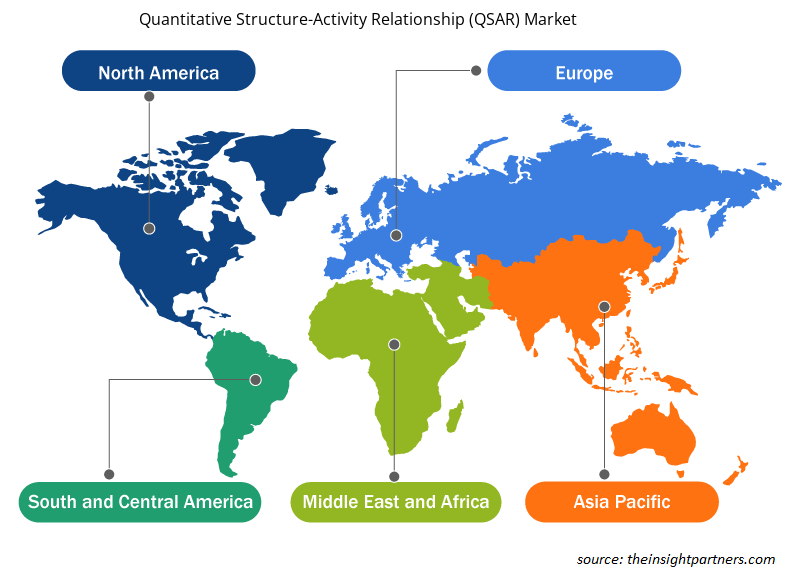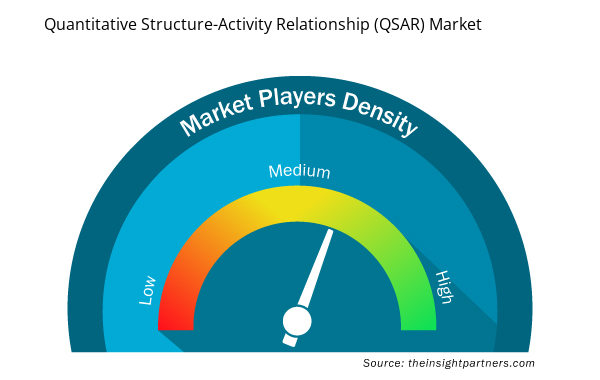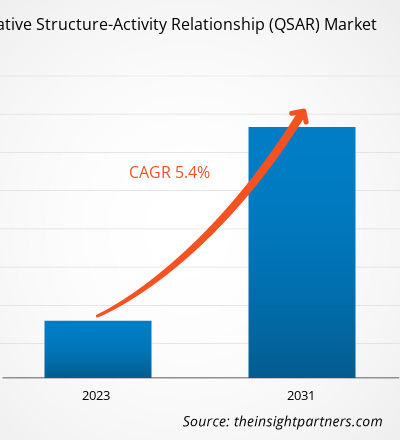The Quantitative Structure-Activity Relationship (QSAR) Market size is projected to reach US$ 2.30 billion by 2031 from US$ 1.54 billion in 2023. The market is expected to register a CAGR of 5.4% in 2023–2031.
Growing adoption of QSAR and artificial intelligence in drug discovery are likely to remain key quantitative structure-activity relationship (QSAR) market trends.
Quantitative Structure-Activity Relationship (QSAR) Market Analysis
A quantitative structure-activity relationship (QSAR) is a computational or mathematical modeling approach to reveal connections between biological activities and chemical compounds' structural properties. It attempts to correlate chemical structure with an activity using statistical approaches. The QSAR models are beneficial for various purposes, including the prediction of actions of untested chemicals. In addition, it helps to prioritize desired biological activities as an in silico methodology and thus decreases the number of candidate chemicals to be tested with in vivo experiments. Key factors that are driving growth of the market are increasing adoption of modeling tools in drug discovery and increasing economic burden of drug discovery. However, less adoption rate of the technique in emerging countries hinders the growth of the market.
Quantitative Structure-Activity Relationship ( Overview
North America is the largest market for the quantitative structure-activity relationship (, with the US holding the largest market share, followed by Canada. This can be attributed to growing numbers of research and development activities, increasing numbers of startups, and rising investments for development of novel and innovative drug candidates targeting rare and incurable diseases and others. The demand for the market in the region is anticipated to witness growth at a significant rate during the forecast period owing to other factors such as government investment in healthcare infrastructure, rising prevalence of chronic diseases, and growing adoption of big data & health IT tools.
Customize This Report To Suit Your Requirement
You will get customization on any report - free of charge - including parts of this report, or country-level analysis, Excel Data pack, as well as avail great offers and discounts for start-ups & universities
Quantitative Structure-Activity Relationship (QSAR) Market: Strategic Insights

- Get Top Key Market Trends of this report.This FREE sample will include data analysis, ranging from market trends to estimates and forecasts.
You will get customization on any report - free of charge - including parts of this report, or country-level analysis, Excel Data pack, as well as avail great offers and discounts for start-ups & universities
Quantitative Structure-Activity Relationship (QSAR) Market: Strategic Insights

- Get Top Key Market Trends of this report.This FREE sample will include data analysis, ranging from market trends to estimates and forecasts.
Quantitative Structure-Activity Relationship (QSAR) Market Drivers and Opportunities
Increasing Adoption of Modeling Tools in Drug Discovery
The quantitative structure-activity relationship is a computational modeling method used for revealing relationships between structural properties of chemical compounds and biological activities. The drug discovery and development with potential therapeutic applications is a complicated, expensive, and time-consuming venture, for which various computational methodologies such as QSAR have been adopted to increase the efficiency of drug discovery. From hit identification to lead optimization, techniques such as a ligand or structure-based virtual screening are widely being used by various pharmaceutical companies. With the help of modeling, existing data can be leveraged to gain product safety and effectiveness insights. Owing to the efficiency of computational methods, the FDA and EMA have incorporated drug modeling to achieve efficient drug development.
Increasing Market Player Initiatives– An Opportunity in Quantitative Structure-Activity Relationship (QSAR) Market
The companies engaged in drug discovery and development are adopting various business strategies to expedite discovery timelines and improve product quality. Several players in this market are focusing on collaboration with innovative biotech companies, academics, and pharmaceutical companies to enhance their respective in silico-based service portfolio and maintain a competitive edge in the industry. Majority of the pharmaceutical companies have been benefited by adopting modeling software, which, in turn is expected to propel the growth of the quantitative structure-activity relationship (QSAR) market during the forecast period. For instance, Schrodinger’s collaboration with Agios Pharmaceuticals, Inc. resulted in two FDA approved therapies with the help of computational platform.
Quantitative Structure-Activity Relationship (QSAR) Market Report Segmentation Analysis
Key segments that contributed to the derivation of the quantitative structure-activity relationship (QSAR) market analysis are disease and imaging modality.
- Based on application, the quantitative structure-activity relationship (QSAR) market is segmented into drug discovery, molecular modelling, chemical screening, regulatory and, decision-making, other applications. The drug discovery segment held a larger market share in 2023.
- By industry, the quantitative structure-activity relationship (QSAR) market is segmented into pharmaceuticals, cosmetics, environmental, food and beverage. The pharmaceutical segment held the largest share of the market in 2023.
Quantitative Structure-Activity Relationship (QSAR) Market Share Analysis by Geography
The geographic scope of the quantitative structure-activity relationship (QSAR) market report is mainly divided into five regions: North America, Asia Pacific, Europe, Middle East & Africa, and South America/South & Central America.
North America has dominated the quantitative structure-activity relationship (QSAR) market. The US is the largest market for QSAR. The growth of this market is primarily driven by the rapid integration of AI for the drug discovery, increasing preference for personalized medicine, high R&D spending for novel therapeutic applications and presence of major market players in the US. In addition, rising collaboration and partnerships of the pharmaceutical companies with the artificial intelligence technology companies for the development of the drugs, further boosting the growth of the market. Furthermore, growing awareness about the artificial intelligence technologies in the pharmaceutical industries will be providing various growth opportunities in the market.
Quantitative Structure-Activity Relationship (QSAR) Market News and Recent Developments
The quantitative structure-activity relationship (QSAR) market is evaluated by gathering qualitative and quantitative data post primary and secondary research, which includes important corporate publications, association data, and databases. The following is a list of developments in the market for speech and language disorders and strategies:
- Cresset, collaborated with Enamine, the leading provider of chemical building blocks and drug discovery services to develop innovative new solutions for the early drug discovery process. (Source: Cresset, Press Release, 2024).
- Royal Free London NHS Foundation Trust entered into 5 years of partnership with DeepMind Technologies (Google), with the expectation that the latter would help the former find treatments for acute kidney damage. An international project called the 100,000 Genomes Project of the UK uses AI and data from individuals with uncommon diseases in the National Health Service. Roche, Merck, and Biogen are also partners in the initiative. (Source: DeepMind Technologies, Press Release, 2020).
Quantitative Structure-Activity Relationship (QSAR) Market Regional Insights
The regional trends and factors influencing the Quantitative Structure-Activity Relationship (QSAR) Market throughout the forecast period have been thoroughly explained by the analysts at Insight Partners. This section also discusses Quantitative Structure-Activity Relationship (QSAR) Market segments and geography across North America, Europe, Asia Pacific, Middle East and Africa, and South and Central America.

- Get the Regional Specific Data for Quantitative Structure-Activity Relationship (QSAR) Market
Quantitative Structure-Activity Relationship (QSAR) Market Report Scope
| Report Attribute | Details |
|---|---|
| Market size in 2023 | US$ 1.59 Billion |
| Market Size by 2031 | US$ 2.3 Billion |
| Global CAGR (2023 - 2031) | 5.4% |
| Historical Data | 2021-2022 |
| Forecast period | 2023-2031 |
| Segments Covered |
By Application
|
| Regions and Countries Covered | North America
|
| Market leaders and key company profiles |
Quantitative Structure-Activity Relationship (QSAR) Market Players Density: Understanding Its Impact on Business Dynamics
The Quantitative Structure-Activity Relationship (QSAR) Market is growing rapidly, driven by increasing end-user demand due to factors such as evolving consumer preferences, technological advancements, and greater awareness of the product's benefits. As demand rises, businesses are expanding their offerings, innovating to meet consumer needs, and capitalizing on emerging trends, which further fuels market growth.
Market players density refers to the distribution of firms or companies operating within a particular market or industry. It indicates how many competitors (market players) are present in a given market space relative to its size or total market value.
Major Companies operating in the Quantitative Structure-Activity Relationship (QSAR) Market are:
- ProtoQSAR SL
- Intertek Group Plc
- Dassault Systems SE
- Bibra Toxicology Advice & Consulting Ltd
- Laboratory Corporation of America Holdings
- LATHAM BIOPHARM GROUP
Disclaimer: The companies listed above are not ranked in any particular order.

- Get the Quantitative Structure-Activity Relationship (QSAR) Market top key players overview
Quantitative Structure-Activity Relationship (QSAR) Market Report Coverage and Deliverables
The “Quantitative Structure-Activity Relationship (QSAR) Market Size and Forecast (2023–2031)” report provides a detailed analysis of the market covering below areas:
- Market size and forecast at global, regional, and country levels for all the key market segments covered under the scope
- Market dynamics such as drivers, restraints, and key opportunities
- Key future trends
- Detailed PEST/Porter’s Five Forces and SWOT analysis
- Global and regional market analysis covering key market trends, major players, regulations, and recent market developments
- Industry landscape and competition analysis covering market concentration, heat map analysis, prominent players, and recent developments
- Detailed company profiles
- Historical Analysis (2 Years), Base Year, Forecast (7 Years) with CAGR
- PEST and SWOT Analysis
- Market Size Value / Volume - Global, Regional, Country
- Industry and Competitive Landscape
- Excel Dataset


- Intraoperative Neuromonitoring Market
- Trade Promotion Management Software Market
- Explosion-Proof Equipment Market
- Aerospace Forging Market
- Equipment Rental Software Market
- Travel Vaccines Market
- Military Rubber Tracks Market
- Energy Recovery Ventilator Market
- Machine Condition Monitoring Market
- Greens Powder Market

Report Coverage
Revenue forecast, Company Analysis, Industry landscape, Growth factors, and Trends

Segment Covered
Application ; Industry , and Geography

Regional Scope
North America, Europe, Asia Pacific, Middle East & Africa, South & Central America

Country Scope
Argentina, Australia, Brazil, Canada, China, France, Germany, India, Italy, Japan, Mexico, Saudi Arabia, South Africa, South Korea, Spain, United Arab Emirates, United Kingdom, United States
Trends and growth analysis reports related to Technology, Media and Telecommunications : READ MORE..
- ProtoQSAR SL
- Intertek Group Plc
- Dassault Systems SE
- Bibra Toxicology Advice & Consulting Ltd
- Laboratory Corporation of America Holdings
- LATHAM BIOPHARM GROUP
- NSF INTERNATIONAL
- Creative Biolabs
- QSAR LAB SP. Z O
- Covance Inc. (Labcorp)

 Get Free Sample For
Get Free Sample For